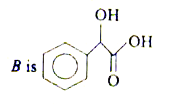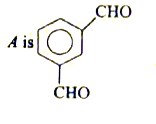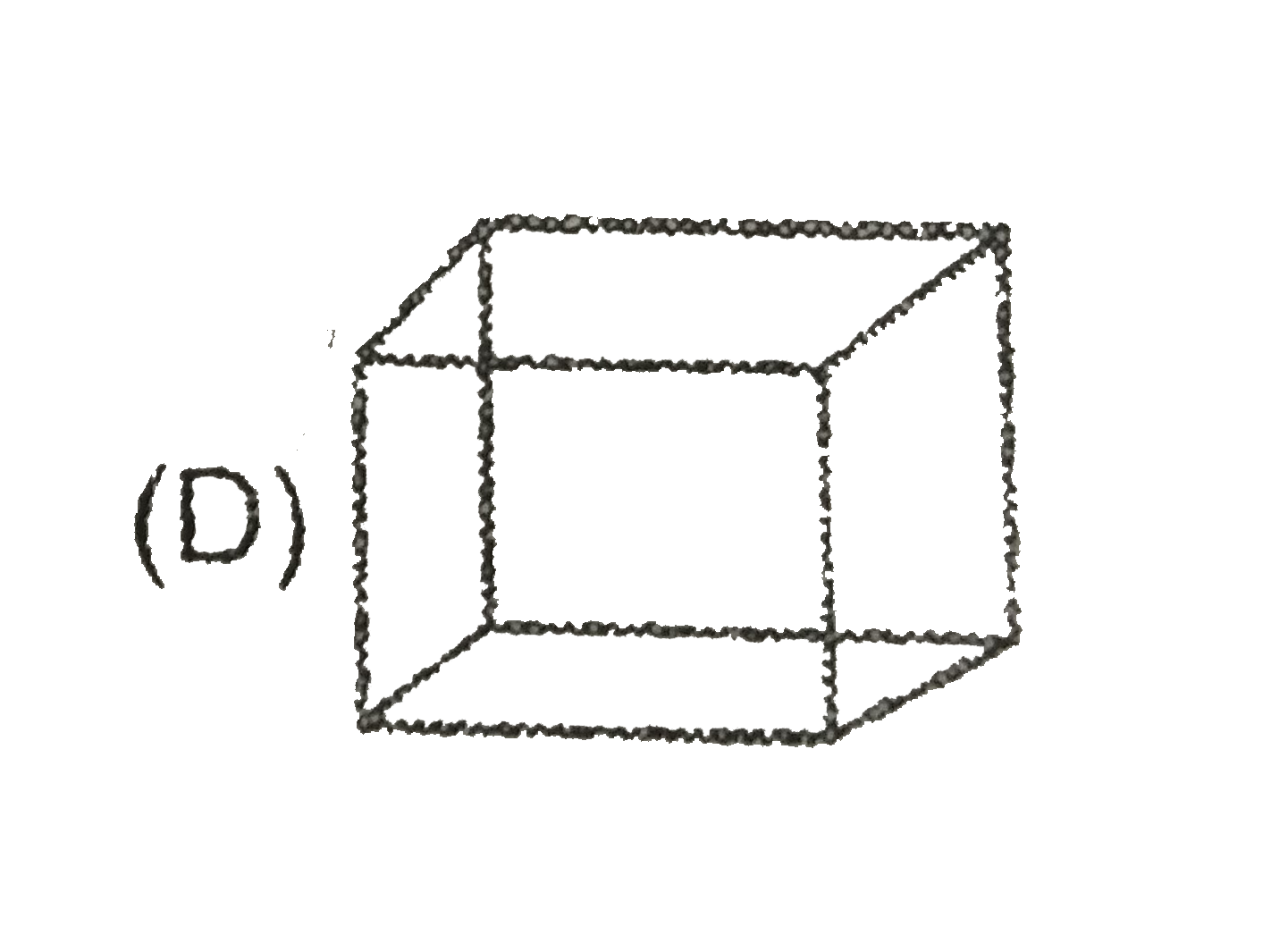An organic compound in dry benzene in the presene of anhydorus gives compound . Compound on treatment with followed by reaction with gives compound which on reaction with hydrazine gives a cyclised compound Idenyify and . Explain the formation of from .
To solve the problem step by step, we will identify the compounds A, B, C, and D based on the given reactions and their molecular formulas.
Step 1: Identify Compound (A)
Given that compound (A) has the formula C8H4O3, we can deduce its structure. The presence of three oxygen atoms suggests that it might contain a carboxylic acid or an ester group. A possible structure for compound (A) is:
- Compound (A): 1,2-benzenedicarboxylic acid (Phthalic acid)
Step 2: Reaction of Compound (A) to form Compound (B)
When compound (A) reacts with dry benzene in the presence of anhydrous AlCl3, it undergoes a Friedel-Crafts acylation reaction. This reaction introduces a benzene ring into the structure.
- Compound (B): 1,2-Diphenyl-1,2-ethanedione (or benzophenone derivative)
Step 3: Reaction of Compound (B) with PCl5
The compound (B) now reacts with PCl5. This reaction replaces the hydroxyl group (if present) with a chlorine atom, leading to the formation of an acyl chloride.
- Compound (C): 1,2-Diphenyl-1,2-ethanedione chloride (or a related acyl chloride)
Step 4: Reaction of Compound (C) with H2/Pd(BaSO4)
The next step involves the reduction of the acyl chloride to an aldehyde using hydrogen in the presence of a palladium catalyst.
- Compound (C): 1,2-Diphenylacetaldehyde
Step 5: Reaction of Compound (C) with Hydrazine
When compound (C) reacts with hydrazine (NH2NH2), it undergoes a condensation reaction to form a hydrazone. This hydrazone can cyclize to form a more complex structure.
- Compound (D): 1,2-Diphenyl-1,2-dihydropyrazine (C14H10N2)
Step 6: Explain the Formation of Compound (D) from Compound (C)
The formation of compound (D) from compound (C) involves the nucleophilic attack of hydrazine on the carbonyl carbon of the aldehyde group in compound (C). This leads to the formation of a hydrazone intermediate, which can further undergo cyclization to form a dihydropyrazine structure.
Summary of Compounds:
- (A): 1,2-benzenedicarboxylic acid (Phthalic acid)
- (B): 1,2-Diphenyl-1,2-ethanedione
- (C): 1,2-Diphenylacetaldehyde
- (D): 1,2-Diphenyl-1,2-dihydropyrazine (C14H10N2)
Given that compound (A) has the formula C8H4O3, we can deduce its structure. The presence of three oxygen atoms suggests that it might contain a carboxylic acid or an ester group. A possible structure for compound (A) is:
When compound (A) reacts with dry benzene in the presence of anhydrous AlCl3, it undergoes a Friedel-Crafts acylation reaction. This reaction introduces a benzene ring into the structure.
The compound (B) now reacts with PCl5. This reaction replaces the hydroxyl group (if present) with a chlorine atom, leading to the formation of an acyl chloride.
The next step involves the reduction of the acyl chloride to an aldehyde using hydrogen in the presence of a palladium catalyst.
When compound (C) reacts with hydrazine (NH2NH2), it undergoes a condensation reaction to form a hydrazone. This hydrazone can cyclize to form a more complex structure.
The formation of compound (D) from compound (C) involves the nucleophilic attack of hydrazine on the carbonyl carbon of the aldehyde group in compound (C). This leads to the formation of a hydrazone intermediate, which can further undergo cyclization to form a dihydropyrazine structure.
- (A): 1,2-benzenedicarboxylic acid (Phthalic acid)
- (B): 1,2-Diphenyl-1,2-ethanedione
- (C): 1,2-Diphenylacetaldehyde
- (D): 1,2-Diphenyl-1,2-dihydropyrazine (C14H10N2)
Topper's Solved these Questions
- BOOK - CENGAGE CHEMISTRY ENGLISHCHAPTER - AROMATIC COMPOUNDS AND ALKYL AND ARYL HALIDES EXERCISE - Exercises Concept Application Type2videos
AROMATIC COMPOUNDS AND ALKYL AND ARYL HALIDES
- BOOK - CENGAGE CHEMISTRY ENGLISHCHAPTER - AROMATIC COMPOUNDS AND ALKYL AND ARYL HALIDES EXERCISE - Exercises Concept Application4videos
AROMATIC COMPOUNDS AND ALKYL AND ARYL HALIDES
- BOOK - CENGAGE CHEMISTRY ENGLISHCHAPTER - AROMATIC COMPOUNDS AND ALKYL AND ARYL HALIDES EXERCISE - Exercises Subjective Type5videos
AROMATIC COMPOUNDS AND ALKYL AND ARYL HALIDES
- BOOK - CENGAGE CHEMISTRY ENGLISHCHAPTER - APPENDIX INORGANIC VOLUME 2EXERCISE - Short Answer Type179videos
APPENDIX INORGANIC VOLUME 2
- BOOK - CENGAGE CHEMISTRY ENGLISHCHAPTER - BIOMOLECULESEXERCISE - Exercises Archives (Analytical And Descriptive)8videos
BIOMOLECULES
Similar Questions
An alkene (A)C16H16 on ozonolysis gives only one product (B)(C8H8O). Compound (B) on reaction with NH2OH followed by reaction with H2SO4,Δ gives N - methyl benzamide the compound 'A' is -
View SolutionTreatment of benzene with CO/HCl in the presence of anhydrous AlCl3/CuCl followed by reaction with Ac2O/NaOAc gives a compound X. Reaction of X with H2/Pd/c followed by treatment with H3PO4 gives another compound Y. The compound Y is :
View Solution
Knowledge Check
- Question 1 - Select One or More
Compound (A) C8H6O2 on treatment with aq. NaOH followed by acidification gives (B) C3H2O3 which on oxidation gives benzoic acid only:
A B
B C
C D
D
Acetoisonitrile on reaction with C2H5MgBr followed by hydrolysis, gives compound (A), which one further hydrolysis gives (B) and (C).
(B) and (C) are :View SolutionAn organic compound (A) (C6H10O) on reaction with CH3MgBr followed by acid treatment gives compound (B). The compound (B) on ozonolysis gives compound (C ), which in the presence of a base gives 1-acetyl cyclopentene (D). The compound (B) on reaction with HBr gives compound (E ). Write the structures of (A), (B), (C ), (D), and (E ). Show how (D) is formed from (C ).
View Solution(i) An organic compound A with molecular formula C7H8 on oxidation by chromyl chloride in the presence of CCl4 gives a compound B which gives positive Tollen's test. The compound B on treatment with NaOH followed by acid hydrolysis gives two product C and D. C on oxidation gives B which on further oxidation gives D. the compound D on distillation with sodalime gives a hydrocarbon E. Below 60∘C, concentrated nitric acid reacts with E in the presence of concentrated sulphuric acid forming a compound F. identify the compounds A,B,C,D,E and F.
(ii) Give chemical test to distinguish : Formaldehyde and acetaldehyde.View SolutionAn organic compound (A) , C4H8Cl2 on hydrolysis forms another compound (B) , C4H8O.
If (B) does not responds to iodo form test , then identify possible structures of (A) and (B).View SolutionFind DU of following compound:-
(A)C8H12 , (B)C5H10 , ( C)C7H8 , (D) View Solution
View SolutionAn organic compound X(C4H8O2) gives positive test with NaOH and Phenopthalein. Structure of X will be:
View SolutionAn organic compound A (C2H6O) reacts with sodium to form a compound B with the evolution of H2 and gives a yellow compound C on reacting with iodine and NaOH. When heated with conc. H2SO4 at 413 K, it gives a compound D (C4H10O) which on reaction wiht conc. HI at 373 K gives compound E. The compound D is also obtained when B is heated with E. Idntify the compounds A,B,C,D and E write the equations for the reaction involved.
View Solution

